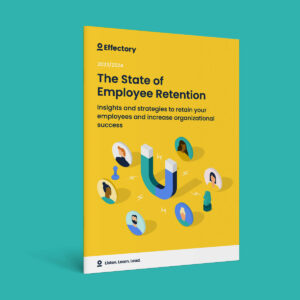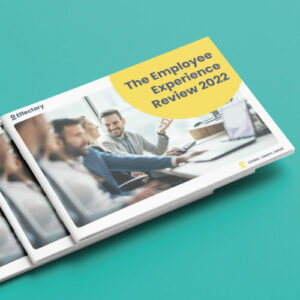Did you know that for midrange positions, the cost to replace an employee is around 20% of their annual salary? And when it comes to replacing people in executive positions, costs may soar up to 213% of their average salary1?
Retention Reality Check: What Makes Employees Stay or Leave Your Organization?

In the heated competition for skilled talent, retaining valuable employees has gone up to the top of the priority list for HR teams. The effects of the Great Resignation are still being felt across continents, leaving organizations facing its challenges.
Is your organization ready to identify and tackle the core reasons why employees choose to stay or leave?
The State of Employee Retention
Uncover why employees leave, hidden costs to organizations, and proven retention strategies in our insightful report.
DownloadThe Great Resignation: A Ripple Across Continents
The impact of the Great Resignation continues to be felt within HR departments. This is understandable, given the significant financial and operational burdens associated with employees leaving their jobs:
The pace of employee turnover is forecasted to be 50–75% higher than what companies have previously experienced. Moreover, the time it takes to fill a position has increased by 18%, further intensifying the operational challenges associated with high turnover rates2.
The pace of employee turnover is forecasted to be 50–75% higher than what companies have previously experienced. Moreover, the time it takes to fill a position has increased by 18%, further intensifying the operational challenges associated with high turnover rates.
The Costs: Beyond Monetary Measures
The financial aspect of employee turnover is only the tip of the iceberg. The operational disruptions, recruitment expenses, and time investment in training new employees are all immediate consequences of high turnover rates. Besides, the knowledge and experience that walk out the door when employees leave are irreplaceable.
Many factors contribute to a person’s decision to leave their job, including organizational culture, training opportunities, and leadership effectiveness. We explored all the reasons in-depth in another article. Make sure to read through to gain a better understanding of the 5 key reasons employees leave their jobs.
Shifting Gears: The Great Retention
Throughout 2023, the focus has shifted from reacting to the waves of the Great Resignation to proactively building a culture of retention – now known as The Great Retention. This shift reflects a better understanding of why employees are dissatisfied and a move towards finding ways to engage and retain them. The need for effective retention strategies is more critical than ever, especially as HR roles themselves are among the top positions people are likely to quit3.
At the core of this transition is the evolving role of HR professionals. Moving beyond traditional models of employee management, HR is now viewed as a key player in shaping and nurturing a positive organizational culture. The focus is on innovative retention strategies that meet modern-day expectations of employees around work-life balance, flexibility, and recognition.
Moreover, the dialogue around retention is expanding to include aspects like mental well-being, personal growth, and career development. HR professionals are now tasked with the responsibility of not only understanding the diverse needs of the workforce but also creating an inclusive and supportive environment where employees feel valued and motivated to contribute to the organizational goals.
Read also: Measure employee inclusion and increase organizational performance – Effectory.
Tuning into Employee Expectations
Understanding what employees want and need from their workplace is essential in creating a culture of retention. A significant aspect of this understanding revolves around work-life balance. The demand for flexibility has surged, with a notable 45% of European companies enabling workers to work remotely for up to three days each week4. This reflects a strong desire for a balanced approach to work, allowing employees to blend their professional and personal lives with more ease.
Strategies such as frequent recognition, celebrating milestones, and personalized rewards have also gained traction, and are being used to enhance employee engagement and, in turn, retention5.
Effectory’s data aligns with these findings, showing a strong link between engagement and retention. When employees feel they fit well within an organization, sense appreciation for their contributions, and see avenues for personal and professional growth, they are more likely to stay. These factors, along with a belief in organizational management and the utilization of employee feedback for improvement, form the foundation of a retention-centric work environment.
Download the Employee Experience Review
Discover how employees around the world are experiencing different parts of the employee journey and how this affects the employee experience.
DownloadMeasuring and Enhancing Retention: A Data-Driven Approach
Moving from understanding what employees desire to actively improving retention requires a clear approach. This is where Effectory’s retention analysis comes in handy. It gives you insights into what’s influencing retention and offers a clear picture of the steps your organization needs to take to improve.
Through this analysis, you can identify patterns that might be impacting retention. For example, it could reveal a link between people looking for other job opportunities and a low score on leadership metrics, suggesting that improving leadership could be a focus area.
The retention analysis is followed up by a call with one of our People Strategy Consultants. This conversation aims to broaden your perspective and offer practical tips to improve retention.
This systematical approach isn’t about a one-size-fits-all solution. It’s about understanding the unique makeup of your organization, learning from the data, and designing strategies that resonate with your employees, making it a good place for them to grow and contribute to the organizational goals.
Conclusion
Navigating the modern-day retention challenge requires a mix of understanding, adaptability, and actionable steps. HR professionals play a key role in guiding organizations toward a culture that keeps and nurtures talent. Effectory’s retention analysis is a handy tool in any HR toolkit, helping to keep your skilled talent onboard.
Why wait for exit interviews to find out why your employees are leaving? Discover what keeps your team engaged and take meaningful action today.
Book a free demo. See our solutions in action.
Effectory is Europe’s Leading provider of Employee Listening Solutions. Schedule a product demo and discover how to enhance your employees’ engagement.
Demo request

